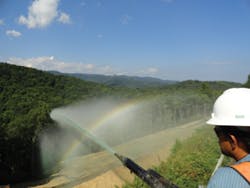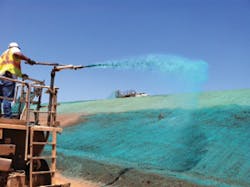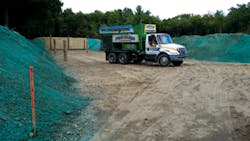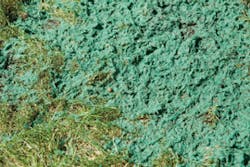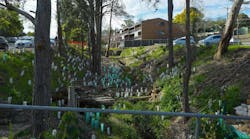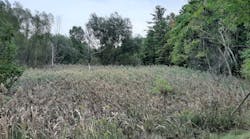Sam Howard and his crew at Central Carolina Seeding in Winston-Salem, NC, have been doing hydroseeding work on a highway project near Blowing Rock, NC. Their work—done in stages—started in 2012 and will finish in the fall of 2015.
“It’s a beautiful area, with pretty steep terrain,” says Howard of the mountainous location, which is a popular destination for vacations and weekend getaways.
The overall project involves widening existing North Carolina Highway 321 to four lanes and straightening out a very curvy section. The total project is 8 miles long, with hydroseeding required for the entire distance.
Howard says the site has “a tremendous amount of earth to move and realign,” with slopes that are “very steep and as high as 200 feet. They’re mostly 2:1, with some at 1 and a half to one.”
The earthmoving contractor on the project is Vecellio & Grogan. The general contractor is Maymead Contracting, working for the North Carolina Department of Transportation (NCDOT).
“We’re stage-seeding,” explains Howard. “As they bring the big slopes down, we start at the top and work down. We start at the bottom and work up in areas where they’ve added material to bring the level of the road up.”
Working in either vertical direction on this project “is pretty challenging,” says Howard. His Central Carolina Seeding crew works on the site about once a month. “Whatever amount the contractors have gotten ready for us, we do that part.”
Seeding on the Highway 321 project has been, and is, “pretty much one time. We’ll do some reseeding if necessary,” says Howard.
The seed mixture used in the project is specified by the NCDOT. This highway blend for western North Carolina includes fescues, Kentucky bluegrass, and crown vetch. The seeds are applied with an Epic C330 hydroseeding machine, along with fertilizer and lime in the slurry.
“Most of our seed comes from Green Resources in Greensboro,” says Howard.
Profile Products’ Flexterra is applied separately and immediately after the seed. No soil amendments or blankets are needed, even though the soil is mostly rock.
Flexterra, a flexible growth medium made of 100% recycled wood fibers, bonds directly with the soil. It minimizes loss of soil via wind or stormwater runoff and is very effective in areas of little rainfall.
“We’re using a lot of Flexterra in the hydroseeding machines,” says Howard. That pleases him because “it’s much easier than having to get people to roll matting over the slopes. It’s much easier and much more effective. We’re having good results with Flexterra.”
He adds that “a lot of DOT people are looking at our work with Flexterra, and so far they’re very pleased.”
As with most highway projects, his crews “have to be careful that the wind doesn’t blow material, because we’re working next to traffic.”
Howard says that the weather has been favorable to the work. “We’ve had adequate rainfall. We’ve been fairly lucky over the last year, only a few real downpours.”
Temperatures at the site have been fairly mild, even in summer. The hydroseeding work has been done year around, though Howard said some snow and delays that the earthmovers experienced kept his crews from working.
The most challenging part of the project is “probably the terrain and access. The contractor has been good about making roads for us, but it hasn’t been easy. Just getting the machines in place is difficult.
“We take everything we need for the one section that we’re working on, and we stay until we catch up to where the contractor is preparing the next section for us,” says Howard.
Another challenge has been working around the blasting that the project has required. “It’s been tricky,” acknowledges Howard. “When the road is shut down to the traveling public, it is also shut down to us. Then we have to wait for the blasting crews to clean up debris.”
As for the revegetation effort, “We’ve got a good stand of grass, and some of the erosion issues are behind. It’s been faster than expected. We’ve got good-looking vegetation.”
Central Carolina Seeding does mostly hydroseeding work on highway projects, but the company recently had an interesting job related to a major North Carolina industry: furniture.
The state’s major furniture centers are in Hickory and High Point. Between the two towns, about an hour’s travel time west of High Point, is Mocksville, where the Ashley Furniture Company is located. The company had purchased a warehouse and wanted to build an addition to the facility. Blythe Development of Charlotte, NC, was the overall contractor.
“There was a tremendous amount of earthwork done for the addition, and we hydroseeded 50 acres,” Howard says.
Hydroseeding on this project was also done in stages. The work began in spring 2013 and finished in September 2014.
“Our main focus was to get the building pad ready for the expansion of the distribution center,” explains Howard. “The parking area for tractor trailers had a lot of slopes ranging from 40 to 60 feet high.”
He says that the most challenging aspect of the Mocksville project was the weather. “A lot of the seeding was done in summer, and we had big summer thunderstorms—one- to two-inch rainstorms in a short period.”
The frequency and amount of all that rain meant that “we had lots of washouts. Areas had to be reseeded often,” says Howard.
The seed used was a mix of fescues and Bermuda, with fertilizer and lime added. JumpStart, a root growth booster by Profile Products, was used to help the grasses get established.
Considering how the site looks now, Howard says, “It has come around nicely. We had to do additional fertilizing, but there is a nice stand of grass.”
On the flat part of the land the crews used straw and Tornado Tack ST-1000, a tackifier from Profile Products made to hold straw in place. On the sloped sections crews applied Profile’s Flexterra.
To perform hydroseeding work for his clients, Howard uses C330 hydroseeding machines from Epic Manufacturing in Greenwood, DE. He has found them to be very reliable.
“We’ve got the high-output option so we can reach 200 or 250 feet. Sometimes the wind can blow in the right direction and help us get the extra distance we need,” he says.
The standard C330 features a load-sensing, pressure compensating hydraulic system. The high-output C330 adds a hydrostatic hydraulic pump to drive the spray pump for more efficient fuel usage.
Tarryall Reservoir
Reese Ladwig owns The Erosion Company in Conifer, CO, a town 25 miles west of Denver. His company includes a division called Dirty Deeds Hydroseeding, which is easy for customers to remember.
From March 2013 through the end of December that same year, Ladwig’s hydroseeding crews worked on a federal job at the Tarryall Reservoir near Jefferson, CO. The project was along an 11-mile stretch of road that runs by Tarryall Creek. More than 50 acres had to be hydroseeded.
“The weather was absolutely horrible,” says Ladwig. We had almost 12 weeks of straight rain. We had to battle through it, adding BMPs [best management practices] alongside the road, with a lot of reseeding and reraking.”
The weather worsened in September, with frequent freezing temperatures at the 9,000-foot-high site. The crew had to spend time warming up the machines before they could start working.
“After September, every morning was a challenge,” says Ladwig.
The most challenging aspects of the project overall were “trying to work through the weather and keeping sediment out of the groundwater going into Tarryall Creek,” recalls Ladwig.
He adds, “We had over 90 acres of disturbed soil at one time, slanting towards Tarryall Creek. We were constantly removing sediment, using BMPs, through daily rainstorms and recontouring the soil, roughening the soil, using earth berms, and anything else we could do to prevent a discharge into the stream.”
Project specifications called for a subalpine seed mixture. This mixture, from Arkansas Valley Seed Co. in Denver, included mountain brome, tufted hairgrass, slender wheatgrass, Rocky Mountain fescue, alpine bluegrass, big bluegrass, purple reedgrass, and spike trisetum.
Along with the seeds, the slurry contained a private-label flexible growth medium, hydromulch, fertilizer, and water. Minimal tackifier (guar gum) was also included.
Photodegradable straw blankets were used, per the project’s requirements. Ladwig says that the very steep slopes (many 2:1 and some 1:1 and 0.5:1) made it “almost impossible to pin down a blanket, which is the obvious choice with so many rocks.”
Ladwig says that his crew got the seed planted, and the moist spring and summer helped it grow well. “We didn’t have to go back,” he says.
As part of the project, the crew also cut and planted more than 150 bundles of willows and more than 6,000 willow stakes in wetland areas.
Through the months of the project, Ladwig’s crew members had plenty of chances to spot wildlife. “We saw bobcats, mountain lions, elk, and mountain goats. In the safety information given to workers, there was a caution about some badgers living in a culvert and rattlers,” he says.
The Erosion Control Company uses Bowie 800 Hydro-Mulchers. “We’ve had a Bowie forever,” says Ladwig.
“It has the gear pump. A thick slurry with flexible growth medium will pump through that size machine.”
Ladwig has even toured the Bowie factory in Texas. The hydroseeding machines, he says, “are all handmade, everything welded and put together there. It’s a family business, with neat people turning out a great product.”
Using a smaller-model Bowie on the 50-acre Tarryall Reservoir project was not a problem. “Water was right there at the creek. We didn’t need a bigger machine. For us, speed is everything. The 800 model can pump 15 loads a day, close to three acres. That’s definitely the machine for our company,” says Ladwig.
Not only was the machine less expensive than larger models, but it’s also easy to move the smaller machine from place to place.
“Our capability of carrying three acres of material with us is awesome,” says Ladwig. “We get a lot of referrals because of that.”
Ladwig’s company does a lot of hydroseeding work for the city of Lakewood, CO. One such job was hydroseeding the Lakewood Police Department’s firearms range, a FEMA job.
“Rains had washed lead down into areas below the shooting range,” says Ladwig.
His company created a berm and rundowns for stormwater. Crews reseeded with green vegetation on the top and a foothills mix, required by the city of Lakewood, on the other sections. The foothills mix includes Gulf annual ryegrass, slender wheatgrass, crested wheatgrass, Canadian bluegrass, mountain brome, hard fescue, side oats grama, buffalo grass, big bluestem, switchgrass, native blue grama, and sand dropseed.
“We only get six months of warm weather, but within three months we had over 80% growth. That’s almost impossible, but we had so much rain,” says Ladwig.
The soil there is “mostly really rocky, sandy loam, with granite in the mountains. It doesn’t make for a good matrix,” says Ladwig. “Vegetation growth takes longer when you don’t have good soil.”
The berms—about 2.5 feet high and 3 feet wide—are around the perimeter of the range. Stormwater runoff flows between the berms. Ladwig’s crew installed a diversion ditch below the berms so that runoff would not flow over their tops.
Stormwater runoff comes from across the road then hits the berms, flows down via the rundown sections, and goes into a drain. Rock and vegetation help remove the lead from bullets.
Ladwig is proud of the gun range project because of the engineering elements that he and his crew (all nonengineers) designed and installed successfully. That was the most challenging part of the project.
“It was a design-build—build it as we went. We were the design engineers. We had to figure out how much water was flowing and how to redirect it,” recalls Ladwig.
And as for cleaning up the lead that was flowing into the local water, “The readings show the water is now clear,” he says.
Attracting Water
Chris Beaudry’s hydroseeding company, Pro-Turf Landscaping, is located in Pelham, NH. The firm does hydroseeding projects in Massachusetts and New Hampshire.
Beaudry relies on John Deere Landscapes for a number of products that will help him give his customers the desired results. One of those products is Moisture Manager, which is the private-label name of Hydretain. Ecologel Solutions of Ocala, FL, makes Moisture Manager exclusively for customers of John Deere Landscapes.
The product is a patented blend of liquid humectant and hygroscopic compounds that attract free water molecules from the air within the soil matrix, acting like tiny water magnets. This vapor would otherwise be unusable by plants and eventually lost to evaporation.
The moisture is collected back in a liquid form, which plant roots can then easily absorb. Through this simple mechanism, Hydretain not only helps keep plants clear of daily wilt cycles and drought but also contributes to more complete usage of water from rainfall and irrigation. Water requirements for vegetation and landscaping can be reduced by half.
Beaudry recommends Moisture Manager “in scenarios where we know it will not be watered as frequently as we recommend, such as a commercial site that would be watered every other day at best.”
He says that Moisture Manager “maximizes the water.” He suggests the product for projects “where we want it to come out absolutely flawless.”
He recognizes that not all jobs have the budget to allow him use Moisture Manager, but “when the budget allows, we often use it.” His crew applies it at the same time as the seed and other products. “It goes in the tank along with the rest of the slurry.”
Beaudry says that when he meets with clients, “We discuss their needs and expectations.” He tells them that the revegetation will take six months to a year. “It won’t happen in the first month.”
But sometimes, he adds, “I can tell that their level of expectation is unusually high. Then I will factor Moisture Manager into the budget. If they’re more focused on a high-quality end result than on spending less on the project, that’s when I use it.”
Recalling projects where his crew applied Moisture Manager, he says, “We’ve done a few athletic fields (part of a municipal park in Andover, MA) and we’ve had fantastic results with it. Every field came in thick and green.”
The seed used was Massachusetts Slope Mix. The mixture includes ladino and other types of clover, creeping red fescue, K-31 tall fescue, red top, and domestic rye.
Another Pro-Turf project that included Moisture Manager was a gun range in Dracut, MA. The 100-yard-long range has very steep berms—20 feet tall—on the sides. The back berm is also steep and measures 50 feet tall.
“They were not allowed to open the gun range until seed germination had reached a certain point, so they were anxious to get going,” says Beaudry.
Along with the same Massachusetts Slope Mix used on the athletic fields in Andover, the project included Dirt Glue. Beaudry likes to use this heavy-duty polymer emulsion that bonds soil particles together. It is made by Dirt Glue Enterprises of Amesbury, MA.
The one-day project was done in spring 2014. Beaudry’s crew drove their hydroseeding machine down the berms. This steepness made for a challenging job.
Pro-Turf Landscaping did another unusual job in 2011 in Massachusetts for an environmental restoration company. The hydroseeding work was around the perimeter of a 1.5-acre pond in Concord, MA. Because there were no roads, the biggest challenge was gaining access. Beaudry and his crew chained their Bowie hydroseeding machine onto a barge. A small tugboat pushed the barge around the perimeter of the pond.
The seed used on the project, Massachusetts Slope Mix, was applied along with Moisture Manager. Dirt Glue was also applied for soil stabilization.
For his hydroseeding jobs Beaudry relies on a Bowie Imperial 1500 and a Bowie Victor 1100. “We like them a lot,” he says.
In the Pipeline
Jack Hollinsworth and Russ Lewis operate J and R Farms, a hydroseeding company in Tuscaloosa, AL. They do mostly pipeline, roadside, and coal mine revegetation.
J and R Farms hydroseeded an area known as the Kingston project for Spectra Energy from Labor Day weekend to the second week of November 2014. The 18-mile natural gas pipeline is in Kingsport, TN.
Hollinsworth said that except for a bit of rain during October, the weather had been good, so the crew did not have to deal with delays. The hardest part of the job was “definitely the access and slope steepness. Some of the slopes were 700 to 800 feet long, with some at 1:1 grade.”
The crew used a Pennsylvania seed mixture that contains fescue, orchard grass, perennial rye, switch grass, and several types of clover, applied with their reliable and versatile Finn T330 and T170 HydroSeeders. Hollinsworth, who bought his first T330 in 2000, says the machines are “very dependable and very operator-friendly.”
Soil at the site is of good quality. Along with the seed, the slurry included slow-release fertilizer and Profile Products’ Flexterra on the steepest sections. On flatter sections, Profile’s 70/30 tackifier was used instead of Flexterra. No blankets or mats were needed.
Crew members numbered about 16 on the Kingston project. J and R Farms keeps six or seven workers and a T330 HydroSeeder at home in Tuscaloosa County. They stay busy doing the county’s roadside revegetation jobs.
Hollinsworth and Lewis started their company in 2006. During their busiest season they’re already up to 35 employees. “Seventeen or 18 guys are pretty much full-time now,” says Hollinsworth.
In the last year or so, J and R Farms has done hydroseeding on a number of coal mining reclamation projects. Companies the firm has worked for include Walter Energy, Southland Resources, and Cahaba Resources.
